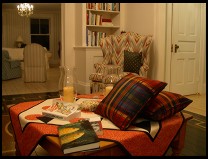
Nikon 995
by Philip Greenspun; created 2001
Site Home : Photography : Nikon 995
Suppose that you're eating at an outdoor cafe and see an interesting picture materializing. Pull your Nikon Coolpix 995 out of its case (the camera is too large to fit in a pocket). Remove the lens cap. Twist the body so that the optical and digital viewfinders are both facing you. Turn the camera dial from Off to "A" (careful not to turn the same switch all the way to "arrow" or the camera will be in playback mode and incapable of taking a picture). Press the shutter release. Nine seconds later, the camera will take a photo.
You had some previous experience with digital cameras and you knew that you'd want to show this magnum opus to your friends at the table. So you held the shutter release down in order to hold the photo on the camera's monitor. No such luck. The picture disappears. What you were supposed to do was, within a couple of seconds of exposure, use your other hand to press the flash mode button to keep the picture on the monitor. Alternatively you could have pressed the focus mode button to discard the photo immediately. Not that it really matters. Assuming it was a sunny day that lured you outside, you won't be able to view the image on the Nikon 995's LCD. It isn't multicoated against reflection.
Consider your buddy with his 35mm film point and shoot, perhaps a venerable old Yashica T4. He whips it out of his shirt pocket (typical P&S cameras are 7 ounces with battery; the Nikon 995 weighs 16 ounces). The camera is already prepared with the lens pointing forward, the viewfinder pointing backward, and the shutter release on top; no need to twist. He turns it on and the lens cover retracts automatically. Point and shoot cameras have been excoriated for shutter lag but even the worst will autofocus, compute exposure, and release within less than one second. What about creative control? Your buddy can lock the focus by pointing the camera at an off-center subject and pressing the shutter release halfway down. You can't (unless you're willing to go through a bunch of menus on the 995). Your buddy has central area metering and exposure lock, again accessible via holding the shutter release halfway down. Can you do this with your 995? Sure but be prepared to read the manual. A few times. If your buddy has color negative film loaded in his point and shoot, he has at least 10 bits of dynamic range and maybe more like 12. This means that his film has a chance of capturing detail in both the highlights and shadows of a contrasty scene. The resulting negative may be tough to print but the information is there. With your Nikon 995 you have 8 bits of dynamic range. Unless it is a cloudy day, large parts of your picture will probably end up pure white or pure black.
Your friend is crushing you photographically. He has a better tool for most purposes with a vastly simpler user interface. You're thumbing through the 178-page manual that you carry with you at all times (it isn't on www.nikonusa.com). He is thinking about photography.
What's good about the Nikon Coolpix 995? If you're willing to immobilize your subject(s), leaf through the owner's manual, and perform a few experiments, the camera can handle many specialized photographic situations that would otherwise require a much more expensive digital camera or a film-based camera system. The 995 accepts IBM Microdrives. You can pop in a 1 GB drive and take 1000 pictures before reloading. The 995 offers useful macro capabilities, e.g., the ability to fill the frame with an object less than one inch (25mm) long. The 995 can be manually focussed. The 995 accepts an extensive range of supplementary lenses, from wideangles and fisheyes to long telephotos. The 995 can average multiple images for high-quality photography on a tripod at night.
 The Nikon Coolpix 995 is a
3-megapixel chunky point and shoot camera, creating 8-bit JPEGs that are
2048x1536 pixels in size. The lens is equivalent to a 38-152mm zoom lens on a
35mm camera. This is a normal to telephoto range, suitable for portraits and
isolating details within scenes. For wide angle photography you would have to
purchase an adaptor lens and frame all of your images through the LCD
monitor.
The Nikon Coolpix 995 is a
3-megapixel chunky point and shoot camera, creating 8-bit JPEGs that are
2048x1536 pixels in size. The lens is equivalent to a 38-152mm zoom lens on a
35mm camera. This is a normal to telephoto range, suitable for portraits and
isolating details within scenes. For wide angle photography you would have to
purchase an adaptor lens and frame all of your images through the LCD
monitor.
 The optical viewfinder
offers adequate eye relief for eyeglass wearers but does not accurately represent
what is being captured by the sensor. The viewfinder zooms with the lens but only
shows about 85% of the image being recorded. Be prepared for some surprise
elements in your compositions (see the shoe in the beach photo at right, for
example).
The optical viewfinder
offers adequate eye relief for eyeglass wearers but does not accurately represent
what is being captured by the sensor. The viewfinder zooms with the lens but only
shows about 85% of the image being recorded. Be prepared for some surprise
elements in your compositions (see the shoe in the beach photo at right, for
example).
Standard sensitivity is equivalent to ISO 100 but can be manually set to 200,400, or 800 as well. The "Auto Sensitivity" function performed poorly, leaving the camera with the lens wide open and at a shutter speed of 1/30th rather than upping the film speed to 200 or 400. Image quality suffers at ISO 400, as you can see from the image below.
The built-in flash has a guide number of 32 at ISO 100 and the camera can control modern Nikon system flashes (SB-28/28DX/26/26/25/24/22/22s).
 Let's first consider
user interface problems that arise in the camera's idiot mode. The first problem
is that it isn't clear how to engage idiot mode. A Nikon N65 film SLR's mode dial
contains a bunch of black and white symbols and pictographs. It also contains a
big green camera icon, labeled with the word "Auto". Other Nikon film SLRs have
dials with settings labeled "simple" and "advanced". With the Coolpix 995 the
option to go for idiot mode is not distinguished by color, is not separated from
the on/off switch, and is not separated from the "playback mode".
Let's first consider
user interface problems that arise in the camera's idiot mode. The first problem
is that it isn't clear how to engage idiot mode. A Nikon N65 film SLR's mode dial
contains a bunch of black and white symbols and pictographs. It also contains a
big green camera icon, labeled with the word "Auto". Other Nikon film SLRs have
dials with settings labeled "simple" and "advanced". With the Coolpix 995 the
option to go for idiot mode is not distinguished by color, is not separated from
the on/off switch, and is not separated from the "playback mode".
Suppose that a new user of the 995 has somehow managed to get into idiot mode. Our novice is trying to take a picture in a home living room. It is a bit dark and the camera would really like to use flash. How is this communicate to the photographer? Via a flashing red light next to the viewfinder. Knowing that something must be wrong, the photographer refers to the big LCD monitor on the back, where reams of text often appear. Do the words "Please slide the switch on top of the viewfinder/lens twisty to pop up the flash" appear on the screen? No. Nothing does. Our photographer is supposed to refer to the 178-page manual if he or she wants to know what this flashing means.
What about a sophisticated photographer? This person has turned the camera's off/auto/manual/playback dial to "manual". By default, manual mode is actually fully automatic as far as exposure and focus are concerned. Our photographer presses menu. There are actually three menus from which to choose. There is Shooting Menu 1, Shooting Menu 2, and Setup. These are selected by picking tabs on the far left of the screen. It isn't clear what distinguishes the two shooting menus and why it isn't simply one longer menu like the two-screen setup menu. Suppose our photographer selects Shooting Menu 1. Each item is indicated by a cryptic icon. Because nobody could possibly figure out what these mean, as one rolls the cursor over the icon a text explanation reads out on top of the screen. The fourth item is "Best Shot Selector" (BSS). The menu prints out enough text to let the photographer turn this on and off but not enough to explain what BSS is. For that, our photographer must refer to page 102 of the manual. Given that our photographer has paid for $900 of computer hardware that includes a bit-map display, why can't the menu system offer a help option for each item? In the case of BSS this would say "Useful for macro and in low light. Holding the shutter release continuously will result in up to 10 images being taken and only the sharpest being written out to the flash card." That's about 175 bytes of text.
About halfway through the design process, the engineers at Nikon must have realized that they had no clue how the camera's controls should be laid out. So they provide extra menu user interface to let the photographer finish the job! The mode and exposure compensation buttons on top of the camera, near the shutter release, are labeled "mode" and "+/-". With the main switch set to "A", they do nothing. You'd think a message would appear on the LCD saying "To activate these buttons, switch to M" but in fact nothing happens at all. In M, the mode button, in combination with the thumb dial, let's you switch among the usual shutter-priority, aperture-priority, manual, and program automation for exposure. The exposure compensation button, again in conjunction with the thumb dial, makes the image darker or lighter. These buttons are also labeled "func. 1" and "func. 2". If you wade through enough menus you can set func. 1, for example, to scroll among mountain, macro, and self-timer modes, thus duplicating a dedicated button for this purpose on the back of the camera. You could also set func. 1 to duplicate the flash mode button on the camera back. func. 2 can be similarly set. Have some fun by setting these, handing the camera to a friend, and demanding that he or she engage aperture-priority exposure or +1 stop exposure compensation.
Like the woman at the Catskills resort who complained that the food was terrible and also that the portions were too small, let's close this section with a complaint about how slow the 995 is. It is slow to wake up. By default, the camera will go to sleep after 30 seconds to save power. Waking up to take or view a picture takes an agonizing second or two. If you're accustomed to a film camera or a high-end digital SLR, this will drive you crazy.
 The Nikon Coopix 995
comes with two bundled software applications. Both are image cataloging programs
rather than image editing programs (i.e., you'll still have to buy Adobe
PhotoShop or Microsoft PictureIt!). One is called "Nikon View 4" and the other is
"Cumulus", a third-party image database management system. After installing all
the software onto a Windows 2000 laptop, it was a pleasant surprise to find that
Nikon View woke up upon the insertion of a flash card into the laptop's PC Card
slot. A small window popped up inviting me to transfer the contents of the flash
card onto the computer. I accepted the invitation, the images were copied, and
the pop-up disappeared.
The Nikon Coopix 995
comes with two bundled software applications. Both are image cataloging programs
rather than image editing programs (i.e., you'll still have to buy Adobe
PhotoShop or Microsoft PictureIt!). One is called "Nikon View 4" and the other is
"Cumulus", a third-party image database management system. After installing all
the software onto a Windows 2000 laptop, it was a pleasant surprise to find that
Nikon View woke up upon the insertion of a flash card into the laptop's PC Card
slot. A small window popped up inviting me to transfer the contents of the flash
card onto the computer. I accepted the invitation, the images were copied, and
the pop-up disappeared.
Where were my pictures? I started Nikon View 4 from the Start menu. The application came up, festooned with fancy 3D icons. No images. No folders. The Open command was greyed out on the File menu. After 5 minutes of clicking around, I still couldn't find the images. The help command in the application does not bring up the user's manual for the application; that comes in a PDF file on a separate CD-ROM (no, it isn't available on www.nikonusa.com).
Using the Microsoft operating system tools, I was able to find the images. They were under a subdirectory in the Nikon View 4 folder. I started Cumulus, the bundled database application. After a few minutes, I was able to create a "catalog" and import the folder containing the images from the 128 Mbyte flash card. The computer chugged away for a few minutes, presumably spending most of its time generating thumbnails. After 61 images had been imported, a dialog box came up. The monster database of 61 pictures was at the limit of the version provided free by Nikon. Would I like to visit Canto Software's Web site and pay for an upgrade? Given that (1) this is database software that uses a proprietary format, and (2) Canto Software doesn't publish Cumulus's documentation on the Web, it seemed wiser to trash the application.
Back to Nikon View 4. Perhaps it would work better on a different computer. I put the disk into a desktop computer: "This software is not compatible with your operating system [Windows NT]".
Back to the laptop. This time I tried (1) starting Nikon View 4 first, and (2) connecting the camera up via the USB cable. At first there was a reassuring dialog box about "New Hardware Found, Nikon 995". Then an error message about multiple devices not being supported. Then "Your computer must be restarted". I waited for Windows 2000 to reboot. The same little Image Transfer pop-up appeared upon reboot. I rolled the mouse over the obscure icons long enough to figure out which one was "Exit". I brought up Nikon View 4. There is a Transfer command on the File menu but it was greyed out. No images. Unplugging the USB cable from the back of the computer and plugging it back in resulted in a tree showing up in the "Select Folder" area. At the top of the tree was "Card reader" (actually the camera). Underneath was a folder entitled "100NIKON". Clicking on the folder resulted in thumbnails showing up in the main window. All of the vertically exposed images were incorrectedly oriented. However, one nice thing was that the camera settings were available in a third window.
There is no "Select All" option from Edit but with some mousing and scrolling I was able to select all the images from the folder. This caused the Transfer option on the File menu to become active. I transferred the images again. I was never asked for a folder name. No new folders showed up on any menu. It seems that Nikon View 4 is only useful for feeding images into a third-party database application. And the third-party application bundled with the 995 is only good for 61 images. And Cumulus stores images in a proprietary format that will make them tough to retrieve and process programmatically.
I gave up on the Nikon software and started up a year-old version of Canon's Zoom Browser EX software. I clicked the right mouse button and selected the "New Folder" option. I inserted the flash card in the laptop's PC card slot. It showed up in the Canon Browser as the E: drive. I doubled click on that and the thumbnails appeared. I clicked "Select All" and then dragged the mouse into the new folder. The images were transferred, albeit without camera setting information.
 Nikon supplies a rechargeable
Li-ion battery with the Coolpix 995. Nikon rates this for 110 minutes of use with
the LCD monitor engaged. In practice the battery was just beginning to fade after
about 70 pictures taken over four days. One great thing about this camera is that
the battery compartment will take a standard 2CR5 disposable lithium battery as
an alternative to the rechargeable battery. So you can carry a lightweight spare
or, in a pinch, buy a battery at any drugstore. The battery cannot be charged in
the camera. You'll be traveling with a separate charger and cable.
Nikon supplies a rechargeable
Li-ion battery with the Coolpix 995. Nikon rates this for 110 minutes of use with
the LCD monitor engaged. In practice the battery was just beginning to fade after
about 70 pictures taken over four days. One great thing about this camera is that
the battery compartment will take a standard 2CR5 disposable lithium battery as
an alternative to the rechargeable battery. So you can carry a lightweight spare
or, in a pinch, buy a battery at any drugstore. The battery cannot be charged in
the camera. You'll be traveling with a separate charger and cable.
The camera's clock is supposed to run on an internal rechargeable battery that draws power from the Li-ion battery. In practice this proved not to work. Despite the camera having been fitted with a fully charged Li-ion battery for several days, the internal clock lost its setting when the main battery was removed overnight for charging. When the clock isn't set, the Nikon 995 goes into "mid-1980s VCR user interface mode". Instead of the words "Please press the menu button to set date and time" appearing on the LCD screen, a tiny cryptic icon flashes continuously. If you have good eyesight and a good imagination, you may surmise that this icon represents a clock. Actually setting the date and time requires persisting through several main screens of menus and scrolling through many irrelevant options before finally getting to the date/time screen.
In the image above right, note how the camera seems to have focussed on the steel support for the boat canopy, rather than the boat captain. It really was beyond my capabilities to keep the camera set for single-shot autofocus.
Watch white balance carefully. The image at left below shows what happens when you take pictures indoors and leave everything on auto. Not too accurate, eh?
| Auto White Balance | Manually set to Incandescent |
|---|---|

|

|
When doing macro photography, make sure that you get the remote release for the 995. You'll probably want to be focussing manually, using a tripod, and having the aperture set to the minimum (for maximum depth of field). Unless you're using electronic flash, this implies a slow shutter speed and the risk of camera shake from your finger on the body's shutter release. With a standard SLR you could address this problem by engaging the self-timer. Unfortunately, on the Nikon 995 the same button that engages the self-timer is also used to select manual focus. It is therefore tricky to keep the camera in "manual focus/self-timer" mode simultaneously.
Here are some examples, playing around with house plants. Aperture was set to f/9.8 (the minimum). Camera was in aperture-priority autoexposure mode with no exposure compensation, resulting in shutter speeds of around 1/2 second. White balance was set to incandescent. Lighting was from some low-voltage track lights. Focus was set manually by looking at the LCD monitor. The camera was on a tripod and the shutter release pressed manually, though carefully. The four images below were collected from a total set of 5 (i.e., it was pretty easy to get the desired picture).




If you want to carry a camera at all times in your pocket or purse, look at a smaller camera, such as the Canon Digital Elph series or the Kyocera/Yashica Finecam S3. For flash photography with a clunky point and shoot, pick up a camera with a hotshoe (e.g., Canon G1). For photography of fast-changing scenes, get a more responsive single-lens reflex digital camera such as the Olympus E-10, the Canon D30, or one of the Nikon D1s.
A digital camera consists of
As photographers, we want high quality and, above all, stability in the software and user interface of digital cameras. In the film world, the user interface of cameras has been extremely stable. A Nikon F3 is exactly like a Nikon F and both are reasonably similar to a Nikon F5. A Leica M6 can be immediately used by someone who bought a Leica M3 in the 1950s. All of the Canon EOS bodies made over 15 years function similarly. As far as post-exposure image processing, most of use filing system that remain unchanged for decades. Technology improvements have been gradual. We adopt them by buying a new lens or putting new film behind our old lenses. Our user interface changes very seldom and very slightly.
In the digital photography world, however, if we want to take advantage of the march of technology, we are forced into learning new software and interfaces every year. Many of these new interfaces are built by people who haven't any experience writing software.
In the world of the personal computer, the split of software and hardware has resulted in users being able to adopt technology improvements without learning new user interfaces. The latest Microsoft Windows operating system (XP; the next rev in the Windows NT/2000 family) runs on desktops, laptops, and Palm-like devices. You can get the fastest processor, the best display, the biggest hard drive, from a competitive group of hardware vendors without adopting any of their idiosyncratic ideas about user interface. Windows and applications layered on top of Windows can be difficult to learn but at least you only have to learn things once.
Basically what the world needs is a standard operating system for cameras coupled to a standard PC-based software for image database, manipulation, and publishing. The camera operating system would be flexible enough to deal with hardware that contained lens zoom rings versus lens zoom push buttons. Companies like Nikon and Canon would concentrate on pushing the state of the art in image quality, image stabilization, weatherproofing, and control placement. They'd get out of the software and user interface design business. A company called Flashpoint ( www.flashpoint.com) tried to do something like this in the late 1990s. The idea was probably a bit too early--most digital cameras were still being bought by gadget freaks--and the execution was poor (i.e., the FlashPoint operating system wasn't significantly better than code written in-house by Canon, Olympus, et al). But in my opinion this is where the industry will end up in 2010.
The camera reviewed was lent by the kind folks at
PhotoAlley.
Text and photos
Copyright 2001 Philip
Greenspun.